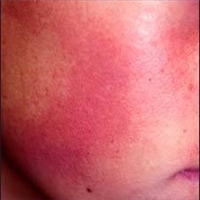While keratosis pilaris usually affects patients on the upper arms, it can potentially show up on any part of the body, except for your palms and the balls of your feet.
When it shows up on the cheeks or face, it’s commonly mistaken for acne. Many times it’s even misdiagnosed this way. With nearly have of all people having KP these days, it’s no wonder that so many people are complaining about their persistant acne not clearing up even with medication. Many of these cases are simply misdiagnosed keratosis pilaris on the face.
This is especially true among teens and adolecents, as an estimated 60% of teenagers have KP, yet because of their age many parents will simply dismiss their symtoms and outbreaks as acne.


As you can see from the pictures above, while the top photo is more easily diagnosed as KP because of the more pronounced bumps, the lower photo might be mistaken for acne or a common rash, even though they are both cases of keratosis pilaris on the face.
Aside from looking up close in a mirror for the bumps, another way to find out if you have KP or not is to feel the affected area. If it feels a little rough, that’s a common symptom of KP.
Recently, an all natural treatment for keratosis pilaris has been getting a lot of national media attention. Many people are attributing their being KP free to this new system, which uses commonly available ingredients that can be bought at any grocery store. You can learn more about it here.